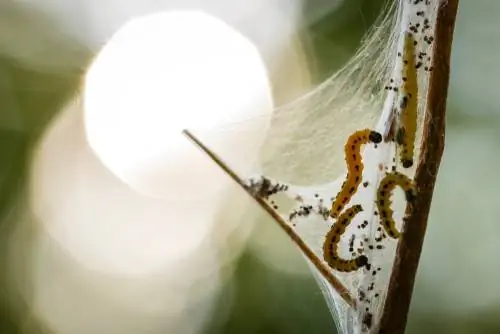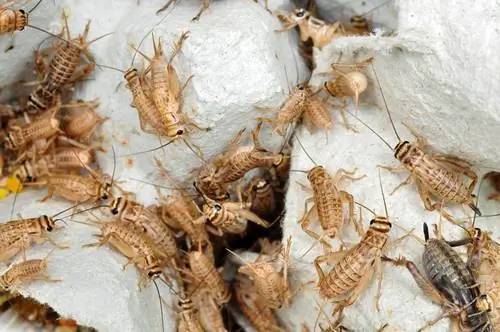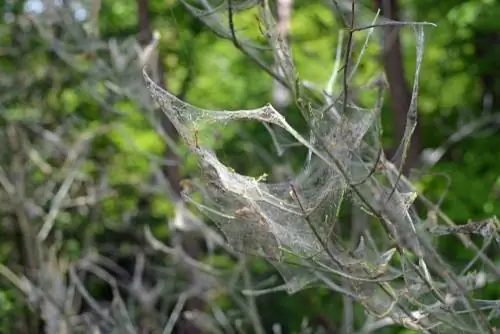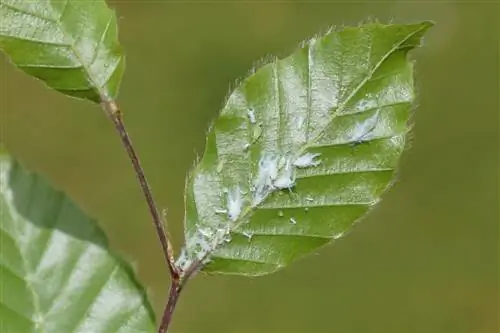- Author admin [email protected].
- Public 2023-12-16 16:46.
- Last modified 2025-01-23 11:19.
Many trees are completely covered in a white web in summer. For some people, this phenomenon looks spectacular. Other nature lovers fear a plague. The reason for this fear is the poisonous oak processionary moth. However, the web moths have little in common with this one.

Pests or useful?
Web moths are considered tree pests because they sometimes occur in large numbers and often eat entire stands of trees bare. In general, the web moths pose no danger to the affected trees because they usually pupate before the second leaf shoot. Many trees and bushes produce leaves again after June 21st, so there is no trace of the original damage. An ecological benefit of butterflies and caterpillars is that they provide food for other animals.
Be careful with permanent infestation of fruit trees:
- Mass reproduction when natural enemies are missing
- Fruits are dropped
- Fruits that have already developed reach a smaller size
- reduced resistance to environmental influences
Web moths do not damage the tree, even though they often eat entire stands bare. In late summer the spook is over again.
Are spider moths poisonous?
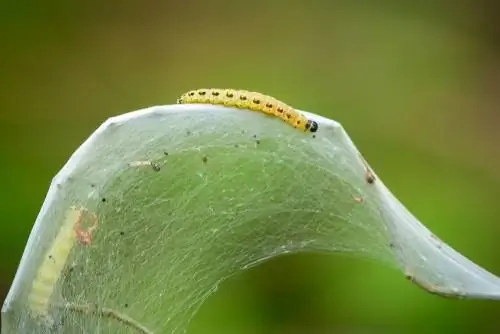
The web moth is not poisonous
Neither butterflies nor caterpillars are poisonous or dangerous for pets and humans. They have specialized exclusively in plants and, unlike the oak processionary moth, do not have any poisonous stinging hairs. This butterfly goes through similar development cycles and exhibits comparable lifestyles to the web moths. However, the stinging hairs can cause itching and severe allergies.
The oak processionary moth does not develop webs. The caterpillars live gregariously in unprotected clusters in order to forage for food. There are also other differences between the web moth and the oak processionary moth that are easily recognizable.
Oak processionary moth profile:
- Forewings shiny ash to brown gray with two cross bands
- Hindwings darkly fringed, yellowish-white and dusted with grayish color
- Caterpillars with a dark back line, velvety hairy areas and red-brown, long-hairy warts
What to do against web moths?
Remedies against web moths have an extremely limited period of effectiveness. If the caterpillars have already developed webs, spraying them won't do much good. The fine structures are so dense that no droplets can get inside. Plant protection products are only effective when the caterpillars leave their clutch and crawl freely on the wood.
Bacillus thurigiensis
This bacterium proves to be an effective control agent against web moth larvae. They ingest it with their food so that it enters the digestive tract. Here it develops its toxic effect on the larvae. The caterpillars stop eating and die. Success will only be achieved if you use products containing this bacterium between mid-April and mid-May. The caterpillars are only susceptible in the first larval stage.
Use spray only in emergencies
A chemical-based control agent usually does not have a selective effect, but also damages beneficial insects such as ladybirds or earwigs. A shoot spraying is recommended for infected apple trees. The tree is completely treated with a product containing paraffin oil. However, the period of application plays an important role. If you spray too early, the eggs are still in the dormant phase and are protected by their shield. Late spraying damages the tree when it is already budding.
Approved sprays for ornamental trees:
- Organic Pest Free Neem
- Pest-free Calyso
- Caterpillar-free XenTari (for apple trees)
Get rid of it naturally
You should prefer biological control so that you do not cause additional damage. Since the trees usually recover, targeted control is usually not necessary. Instead, ensure that natural enemies are encouraged in the garden. Some measures will help you if the caterpillars appear again every year.
Collect
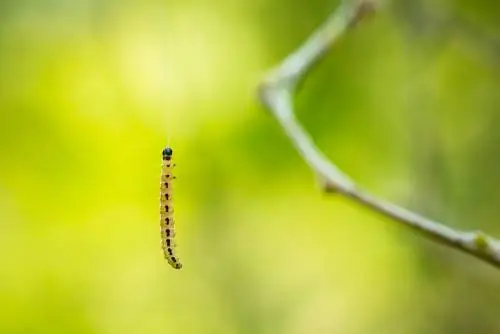
Collecting the caterpillars is not particularly time-saving but effective
The easiest way to combat it is to regularly check for an infestation. Collect the caterpillars as soon as you find them. The fine webs can be swept away with a broom. Place a cloth under the tree beforehand so that you can remove the caterpillars afterwards. To prevent the overlooked caterpillars from crawling back onto the tree, you should put glue rings on the trunk. The caterpillars stick to it and die.
Other methods:
- cut out slightly affected branches
- Remove thin webs with a hard jet of water
- Do not dispose of leftovers in the compost but in household waste
Hot water
To save the caterpillars a painful death due to lack of food, you can pour boiling hot water over them. This measure is environmentally friendly and ensures that the caterpillars die immediately. It also destroys the caterpillars in protected egg clutches, which you can scrape off the trees before winter.
Pheromone trap
You can buy an attractant trap that contains special pheromones in stores. The butterflies fly into the trap and stick when they settle on the glued surfaces. This prevents the animals from mating, so the number of eggs is reduced. Because pheromones are species-specific, you need to choose the right pheromone trap.
Excursus
Mating
The females look for suitable food plants so that their offspring have ideal living conditions. They are based on the scents emitted by the host plants. Once they have sniffed out the right plant, they settle on the leaves. Males also use their sense of smell to locate a female that is capable of mating. This emits a pheromone to attract attention.
wood cuttings
If you noticed an infestation in the summer, you should cut the tree back just before winter. Check the branches for eggs and overwintering caterpillars. The clippings should not be disposed of in the compost, but rather taken to the nearest waste yard.
Tip
Infected branches can also be cut off during the summer, as long as the webs have not yet covered the entire tree.
Natural Regulation
Web moths have no advantage when they reproduce en masse. If uncontrolled spread occurs due to optimal weather conditions, natural opponents quickly emerge. They contain the stocks and thus ensure a natural balance. If a species has enemies, a plague is automatically prevented. Chemical pest control is therefore necessary in a few cases.
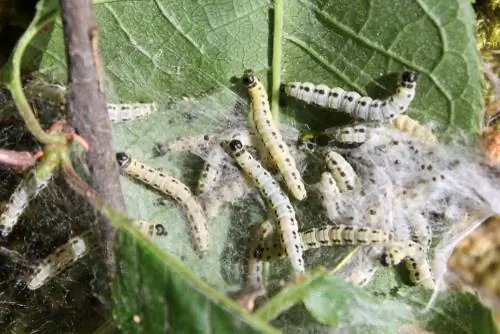
Nature itself often curbs spider moth infestations
Scarce food resources
As more and more caterpillars develop, the food supply becomes increasingly scarce. Hunger stress occurs, causing numerous caterpillars to die before the last pupation. The caterpillars that have passed the final stage of development live as so-called starving females. They are smaller than normal females and have limited fertility. The further reproduction of the butterflies is then increasingly restricted.
Diseases
Particularly large populations are also contained by parasites and pathogens. These natural enemies only appear when the caterpillar population has already expanded en masse. If high humidity arises in overpopulated webs, viruses and diseases spread. Roundworms and fungi are also involved in the natural regulation of the web moth. If such pathogens are ingested in the final phase of development, the caterpillars die within a few days.
This is how a virus manifests itself:
- Caterpillar's body swells
- the larvae burst when touched
- virus-containing fluid is distributed in the web and causes further infections
- dried brown masses visible
Species
The German name indicates the preferred host plants of the respective species. The bird cherry moth occurs on the bird cherry. Occasionally synonyms are also common, as the butterflies target several woody plants. The plum web moth is sometimes also referred to as the sloe web moth. Four species are particularly common in gardens.
| Host plants | Forewing | habitat | Scientific name | |
|---|---|---|---|---|
| Pfaffenhütchen web moth | Pfaffenhütchen, Japanese spindle bush | white, fringed | Biotopes with calcareous soils | Yponomeuta cagnanella |
| Apple web moth | Crab apple, cultivated apple | white | Orchards | Yponomeuta malinellus |
| Plum web moth | Blackthorn, hawthorn, hawthorn, plum, cherry | grayish-white | almost all biotopes with host plants | Yponomeuta padella |
| Black Cherry Spider Moth | Common black cherry, rarely cherry or buckthorn | silvery white | Floodplain forests, stream banks with bushes and trees, gardens, parks | Yponomeuta evonymella |
| Hawthorn moth | Hawthorn, hawthorn, cotoneaster, blackthorn, apple | white with brown stripes | bush edges, gardens | Scythropia crataegella |
General characteristics
Web moths are a family of butterflies that includes around 900 species worldwide. There are around 116 species in Europe, with the typically white butterflies falling into the lower classification of Yponomeuta. This genus has no official German name.

How to recognize web moths
Adult butterflies often have white forewings that are black or darkly spotted. The hindwings appear gray. Web moths have a wingspan of up to 25 millimeters. The shape of the butterflies when their wings are closed is typical. These are reminiscent of a steep roof.
Unique web:
- consists of countless wafer-thin threads
- can be peeled off in long strips
- has an extremely high tear resistance
- Damage will be repaired within a very short time
Food
Caterpillars feed on plant tissue. They mainly eat leaves and needles from the inside. Some larvae also feed on buds and flowers. The caterpillars can be observed on plants from 50 different families. They mainly inhabit sweet grasses and deciduous trees. More than 80 percent of food intake takes place in the last larval stage, which occurs in June. During this phase the caterpillars can eat a tree completely bare.
Natural enemies
Web moths are on the menu of various animals. The most important predators include insectivorous songbirds. A pair of tits feeds around 10,000 different species of caterpillars to their offspring. Birds not only hunt larvae, but also prey on adult butterflies.
The enemies of the web moths are mainly after the proteins, because the caterpillars are extremely high in protein. Until the protective webs are completed, the larvae are eaten by predatory bugs, wasps and flies. But there are also numerous insects that live parasitically and thus limit the spread of the web moth.
| Egg Jam | Larval and pupal parasites | specialized in web moths | ||
|---|---|---|---|---|
| Archwasp | x | x | yes | |
| Green Lacewing | x | no | ||
| Earworm | x | no | ||
| Ants | x | no | ||
| Parasitic wasps | x | yes | ||
| Caterpillar flies | x | yes |
Development
Females lay their eggs in a tile-like arrangement on young shoots and twigs. They cover the clutch with a secretion that hardens quickly and protects the eggs. It takes a few weeks for the first larvae to hatch. A caterpillar goes through four to five instars before transforming into an adult butterfly. Their size increases with each larval stage and their coloring also changes.
Important dates:
- Flight time of the butterflies between June and August
- Mating and laying eggs from July to August
- intensive feeding phase from June of the following year
Stadiums
The newly hatched larva has a light gray to cream color. It hibernates under its protective shield in the first larval stage before leaving the home the next spring. Then the caterpillars start to eat. To protect themselves from rain and predators, they build a fine web. The animals live there sociably, so that sometimes hundreds of larvae can be observed in a web. The webs become increasingly expanded and in the final stage resemble a white veil. Because of these veil-like structures, the moths got their German common name.
Transformation into a butterfly:
- Eating stops four to five days before the last pupation
- 20 millimeter long caterpillars pupate
- Cocoons hang vertically in the dense web of collection
- The moth hatches after ten to 20 days
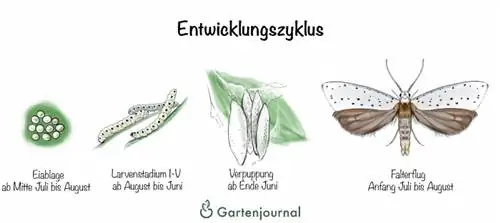
Where web moths occur
The prerequisite for the distribution of the various species is the existence of their host plants. Each species of web moth has specialized on one host, so that only certain trees or grasses are attacked. These occur naturally along stream and river banks, in hedges or copses and on the edges of forests. Numerous trees and fruit trees grow in gardens or parks, which is why the butterflies can also be found in settlements and cities.
Favorite Plant Families
Plum, apple and bird cherry moths are responsible for infesting fruit trees such as cherry or apple trees. While these species are mainly found on rose plants, the willow moth only inhabits pastures. In addition to the Pfaffenhütchen web moth, the buckthorn web moth can also be found on spindle shrub plants. The Sedum web moth lives on thick-leaf plants. Spider moths are not normally found in the home.
- Roses: apple, plum or plum, cherry, serviceberry, grapes, hawthorn, sloe, bird cherry
- Spindle shrub family: Pfaffenhütchen (Euonymus europaeus)
- Willow family: white willow, osier, sal willow, gray willow
- Thickleaf plants: Large butterwort
Massive appearance
It is becoming increasingly common for the webs to cover entire rows of trees and gardens. The caterpillars themselves spin up benches and tables or fence posts. 2017 was such a year. In the Berlin Hasenheide and at Olchinger See, numerous trees and bushes were covered by the fine veils, which caused fear among people.
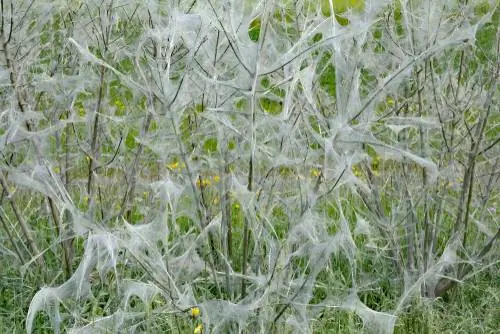
The web moth's work definitely has an aesthetic character
Weather
Particularly mild winter months with little snow favor the survival of caterpillars in the first larval stage, which hibernate under their hardened protective shield. If the summer months after overwintering are particularly hot and dry, there is increased sexual activity in the adult moths.
This prevents mass reproduction:
- rainy periods
- nighttime temperatures below twelve degrees Celsius
- windy conditions
Natural garden
Web moths often occur where the habitat is very one-sided. Avenues with one type of tree and low lawns or orchards with little diversity provide plenty of food for the caterpillars. Make your garden as varied as possible. The more different habitats you create, the more natural enemies will be attracted.
Deadwood
Dead wood and gnarled roots or tree stumps are an ideal habitat for highly specialized insects. Larvae of various beetles or hymenoptera retreat into the moist environment that exists under the rotten bark. Here they are protected from predators and can develop undisturbed.
pile of stones
Climate lizards feel particularly comfortable when they find sunny places in the garden. They need cracks and crevices in the rocks into which they can retreat in case of danger. Lizards feed on various insects, so web moths also end up in their stomachs.
Wild trees
Blackthorn, hawthorn and serviceberry provide optimal feeding conditions for some web moths. Birds also feel at home in wild hedges, finding the caterpillars and butterflies a real treat. Make sure that the hedges consist of different types of trees.
Tip
Bats also hunt for web moths. Support flying mammals with bat boxes and insect flowers.
Frequently asked questions
How old do web moths get?
Adult females have a lifespan of about 60 days. The males die after mating. The egg caterpillars hatch in the same year and overwinter before turning into adult butterflies the following year.
Why do web moths mainly feed in June?
At this time the caterpillars are in the fifth instar. The leaves are still tender enough and contain a lot of nitrogen compounds. These are easy to use and provide the caterpillars with important nutrients.
Do web moths damage the tree?
Although the caterpillars can eat trees completely bare, he althy trees quickly recover from leaf damage. The caterpillars produce large amounts of feces that fall to the ground and are quickly decomposed. This makes the lost nitrogen compounds available to the tree, creating a kind of nutrient cycle. An infestation only becomes dangerous if the caterpillars feed on the same tree every year. This weakens fruit trees in particular.
Do web moths need to be controlled?
In many cases it is not necessary to control the butterflies. Nature itself has developed mechanisms to counteract mass spread. Rainy summer months and high humidity harm insects. If the caterpillars still appear in large numbers, no chemical agent will help. The haunting ends automatically after the summer months. Frosty temperatures in winter cause many egg caterpillars to freeze to death.
Do I have to report web moths?
If you notice a tree infestation that is caused by the web moth, there is no need to worry. The insects do not have to be reported because their populations are regulated by natural enemies. However, the oak processionary moth should be reported because its caterpillars have poisonous hair.

